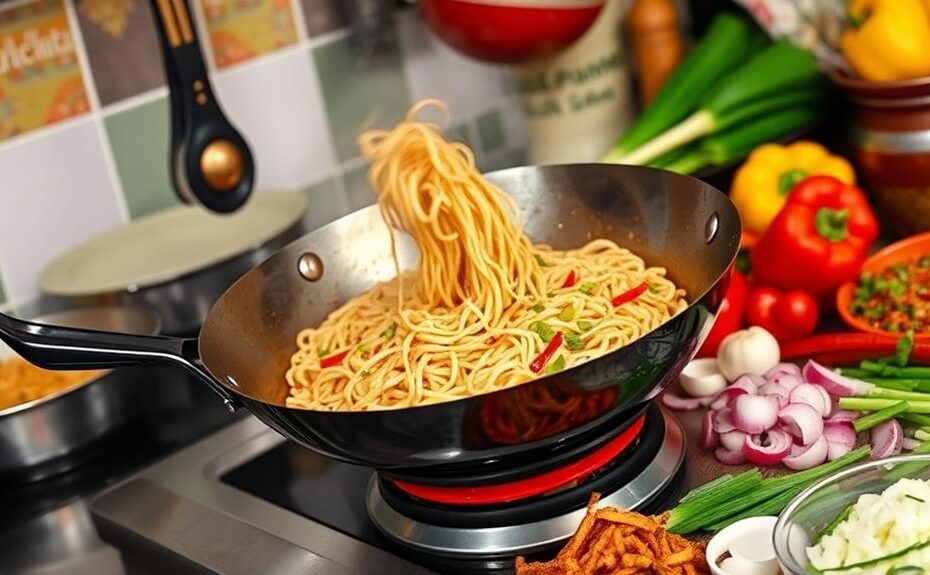Pancit: A Versatile Filipino Noodle Dish
Pancit is a traditional Filipino dish made with rice vermicelli noodles, protein, and vegetables, seasoned with a flavorful base of garlic and onions.
The core ingredients of pancit are rice vermicelli noodles, protein (such as chicken, pork, or shrimp), and vegetables (like cabbage, carrots, and bean sprouts).
To prepare pancit, start by cooking the rice vermicelli noodles according to the package instructions.
Then, sauté the garlic and onions to create the flavorful base.
Add your chosen protein and vegetables, and season with salt, pepper, and other desired spices.
Experiment with different ingredients and techniques to make pancit your own.
For example, add soy sauce or oyster sauce for a savory flavor, or use different vegetables like mushrooms or bok choy.
You can also add other seasonings like patis (fish sauce) or chili flakes for extra flavor.
With these simple steps, you can create a delicious and customizable pancit dish that's perfect for any occasion.
Understanding Pancit Basics
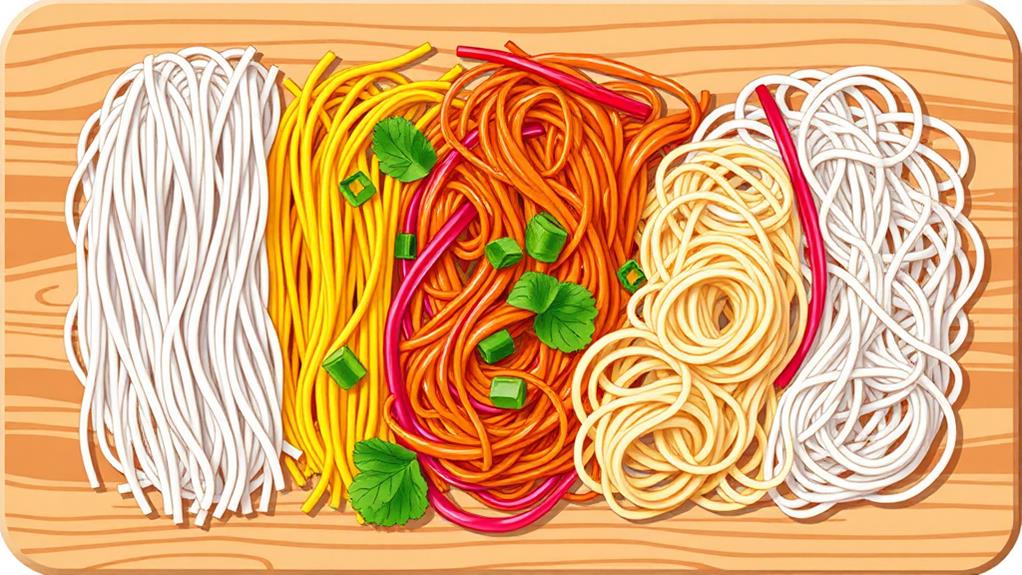
Understanding Pancit Basics
What is Pancit?
Pancit is a traditional Filipino noodle dish that's incredibly versatile, allowing for various ingredient combinations.
It features rice vermicelli or other types of noodles as its base, accompanied by a variety of vegetables and proteins.
Common Ingredients
Common vegetables used in pancit include cabbage, carrots, and green beans, which pair well with proteins like chicken, pork, or shrimp.
These ingredients add flavor and nutrition to the dish.
Seasoning and Cooking
To bring everything together, pancit is typically seasoned with a savory sauce made from soy sauce, garlic, and sometimes oyster sauce, allowing for customization of the flavor profile.
When cooking, veggies and proteins are sautéed before adding the soaked noodles, ensuring even cooking and distribution of flavors.
Cultural Significance
Pancit is more than just a dish; it's a symbol of long life and prosperity in Filipino cuisine, often served during celebrations and family gatherings.
Essential Ingredients and Tools
Stocking Your Pantry and Gathering Tools
To create a delicious and authentic Pancit dish, you'll need the following essential ingredients and tools.
Ingredients
Rice vermicelli noodles are the foundation of Pancit. You'll also need assorted vegetables such as cabbage, carrots, and bell peppers, as well as proteins like chicken, shrimp, or pork.
Garlic and onion are crucial for forming the flavor base of the dish, enhancing its aroma and taste.
Tools
A large wok or skillet is necessary for stir-frying the ingredients.
You'll also need a pot for boiling chicken (if using chicken) and a bowl for soaking noodles.
Seasonings
Salt and pepper are staples for seasoning.
You may also want to use oyster sauce (optional), soy sauce, and a chicken bouillon cube or chicken stock to add depth and richness to the broth.
Cooking Pancit Like a Pro
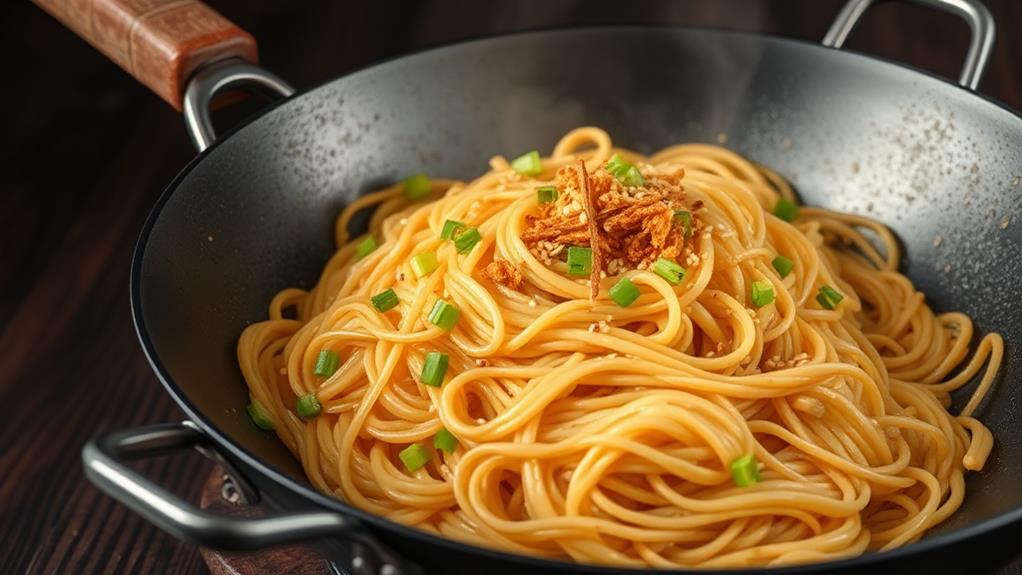
Soaking the Noodles
To prepare rice vermicelli noodles for cooking, soak them in warm water for 8-10 minutes until they're softened. This step allows for better absorption of flavors during cooking.
Sautéing the Aromatics
Preheat a skillet or wok and sauté garlic and onions in oil to create a fragrant base. This base will add flavor to the dish when proteins and vegetables are added.
Adding Proteins and Vegetables
Add proteins like chicken or pork and cut vegetables into uniform sizes to promote even cooking and presentation in the final dish.
Cooking the Noodles
When adding soaked noodles to the pan, stir continuously to prevent sticking and ensure the noodles absorb the broth and seasonings evenly.
Seasoning the Dish
Taste and adjust seasoning as needed using low sodium soy sauce and oyster sauce for a balanced flavor profile without overwhelming saltiness.
Mastering Vegetable Prep Techniques
Uniform Vegetable Sizing
To ensure even cooking, cut vegetables like cabbage, carrots, and green beans into uniform sizes, ideally around 1/4 to 1/2 inch thick.
Using a sharp knife and cutting board helps achieve this while speeding up prep time and ensuring safety by providing better control.
Optimizing Onion and Garlic Prep
Dice onions finely to release their natural sweetness and flavor, which enhances the overall taste of the pancit.
Mince garlic into small pieces to maximize flavor infusion. A garlic press can be used for convenience and uniformity.
Incorporating Color and Texture
Incorporate a variety of colors in your vegetable mix, such as bell peppers and snow peas, to add texture and flavor.
This not only creates a visually appealing dish but also provides different nutrients.
Protein Options and Cooking Tips
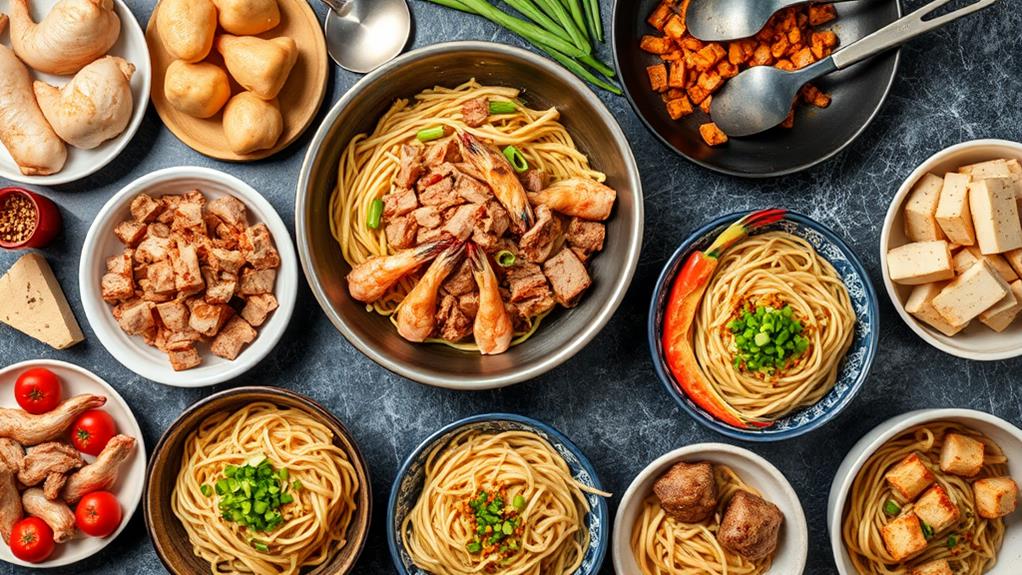
Choosing the Right Protein for Your Pancit Dish
When it comes to protein, you have four popular options to elevate your Pancit dish: chicken, pork, shrimp, and beef. Each protein brings unique flavors and textures to the table.
Cooking Chicken
For tender chicken, use shredded boiled breast meat that absorbs the dish's flavors nicely.
Cooking Pork
Cut pork into bite-sized pieces and brown them in oil with garlic and onions for a savory depth.
Cooking Shrimp
Pre-cook shrimp to avoid toughness, then add them back into the dish with vegetables for a quick finish.
Cooking Beef
Slice beef thinly against the grain for tenderness, and consider marinating it in soy sauce for added flavor before cooking.
Combining Protein and Vegetables
Whichever protein you choose, make sure to cook it with your vegetables and noodles, and don't forget to add a splash of soy sauce to bring everything together.
Noodle Selection and Preparation
Selecting the Right Noodles for Pancit
When it comes to choosing noodles for your Pancit dish, you have four popular options.
Rice vermicelli noodles (bihon) are a traditional choice, requiring only 8-10 minutes of soaking in warm water to soften. They provide a delicate texture that pairs well with your chosen protein and vegetables.
Egg noodles, used in Pancit Canton, offer a chewier texture and can be cooked by boiling directly in the dish with other ingredients.
Udon noodles can be used as an alternative, but they may require different cooking times than rice noodles.
Proper Noodle Preparation is Key
Regardless of the noodle type you choose, separate them well after soaking to promote even cooking and prevent clumping.
Always check the package instructions for specific soaking or cooking times, as different noodle types may have varying requirements for optimal texture.
Flavor Enhancement Strategies
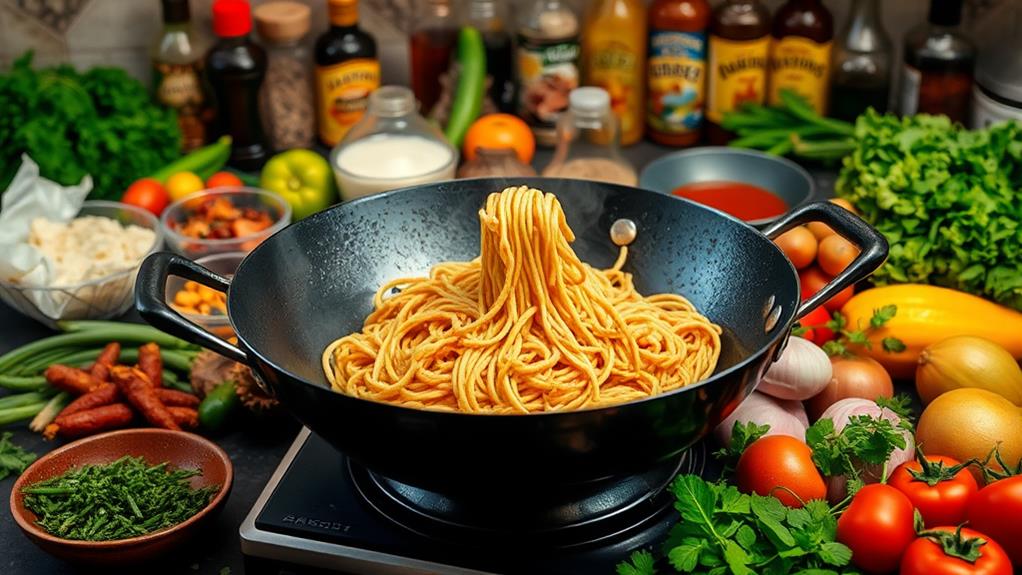
Achieving a balanced flavor profile is crucial in creating exceptional pancit dishes. This balance can be attained by incorporating strategic ingredients and techniques that harmonize savory, sweet, and umami flavors.
Umami boost is achieved by combining soy sauce with oyster sauce, adding depth and richness to the dish. To control saltiness, use low-sodium soy sauce.
To introduce a fresh twist, add fresh herbs like cilantro or green onions as a garnish, providing a burst of freshness and color.
Personalize your dish by experimenting with seasoning blends like garlic powder or crushed red pepper flakes to add an extra layer of flavor or heat according to your preference.
A splash of citrus juice, such as calamansi or lemon, added just before serving, brightens the flavors and provides a refreshing contrast to the savory components of the pancit.
Pancit Serving and Presentation Ideas
Presenting Pancit with Flair
When serving pancit, consider presenting it as a main dish or side, accompanied by traditional Filipino dishes like lumpia or roasted vegetables, to create a well-rounded meal.
Garnish with Fresh Flavors
Garnish your pancit with freshly chopped green onions and lemon wedges, which add a pop of color and a refreshing zest when served.
Showcase Your Pancit
Use a large, shallow serving platter to display your pancit, allowing guests to easily serve themselves while showcasing the vibrant colors of the noodles and vegetables.
Enhance the Dining Experience
Serve your pancit with a side of calamansi or lime wedges, allowing guests to squeeze fresh juice over their servings for added flavor.
Create an Authentic Atmosphere
Use decorative serving utensils, such as bamboo tongs or wooden spoons, to create a more authentic Filipino dining atmosphere when presenting your pancit dish.
Storage and Reheating Methods
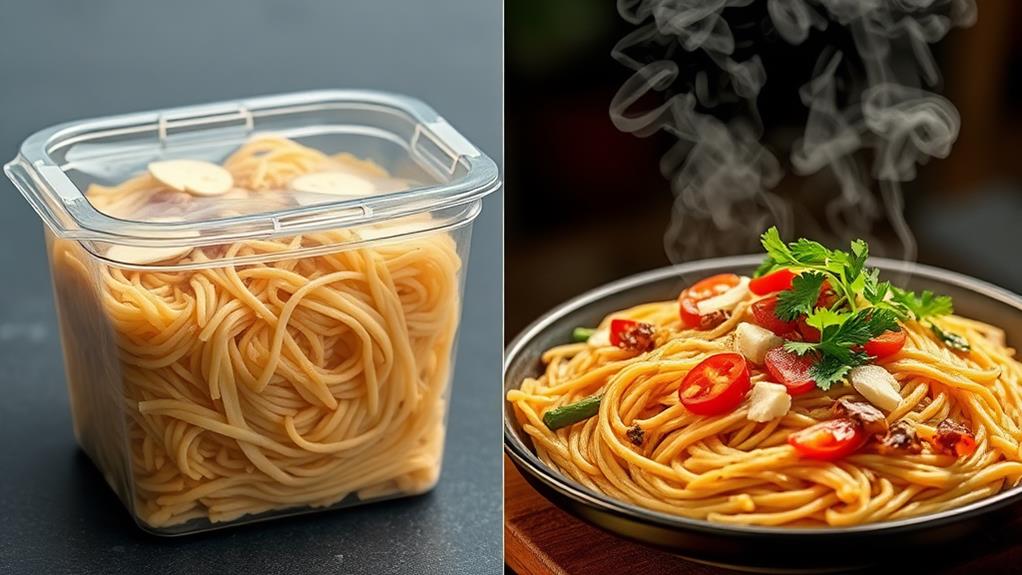
Proper Storage is Key
To enjoy pancit for a longer period, it's crucial to store it properly. There are two options: refrigeration and freezing.
Refrigeration
Refrigerate leftover pancit in an airtight container for up to 4 days to maintain its freshness and flavor.
Freezing
Freeze pancit in a suitable container or freezer bag, where it can last for up to 3 months.
When you're ready to consume it, thaw and reheat frozen pancit in the refrigerator overnight for the best results in flavor and consistency.
Reheating
To reheat pancit, gently warm it in a skillet over low heat, adding a splash of water or broth to prevent drying out and maintain texture.
You can also add fresh vegetables or a splash of soy sauce to revive flavor.
Can I Use This Guide to Make a Perfect Pancit Dish with the Ingredients Listed?
Yes, you can absolutely use this guide to make a perfect pancit dish with the listed ingredients. Just follow the instructions step by step, and you’ll have a delicious and satisfying meal in no time. The perfect pancit dish ingredients will ensure your dish turns out just right.
Troubleshooting Common Issues
Troubleshooting Common Issues in Pancit Dishes
Flavor Issues
If your Pancit Bihon turns out bland, increase the amount of soy sauce, garlic, or add oyster sauce to give it a flavor boost.
Excessive Liquid
To avoid excessive liquid, use the right-sized pan and add broth gradually.
Noodle Issues
When working with noodles, rinse them with cold water after soaking to prevent clumping during cooking.
Aim for an al dente texture instead of overcooking, which can result in a chewy texture.
Vegetable Issues
If vegetables are undercooked, increase the cooking time or add them earlier in the process for a uniform texture.
Frequently Asked Questions
What Is the Filipino Dish Pancit Made Of?
Pancit is a Filipino dish made with rice noodles as its base. These noodles can be either bihon or canton.
The dish typically includes a variety of vegetables, such as cabbage, carrots, and green onions, which add flavor and texture.
Proteins like chicken, pork, or shrimp are also added, providing a boost of nutrients.
The savory pancit broth is flavored with ingredients like soy sauce, garlic, and onion.
What Is the Most Popular Type of Pancit?
Pancit Bihon is the most popular type of pancit.
This classic Filipino dish is made with rice vermicelli noodles and typically features a mix of vegetables and proteins such as chicken, pork, or shrimp.
Its versatility and delicious flavor have led to variations emerging across regions, each with its own twist on ingredients and cooking techniques.
Pancit Bihon is often served at celebrations and gatherings to symbolize long life and prosperity.
What Goes Well With Pancit?
Pancit pairs well with a variety of side dishes. Lumpia, a type of Filipino spring roll, is a popular choice. A fresh salad with mixed greens and vegetables is another option.
Tangy dipping sauces complement pancit's flavors. Calamansi, a Filipino lime, adds a sour and citrusy taste when squeezed over the noodles. Vinegar-based dressings, such as a mixture of vinegar, soy sauce, and garlic, also pair well.
Adding protein or vegetables enhances the meal. Adobo, a Filipino dish made with meat or seafood, vinegar, soy sauce, and garlic, adds a savory and meaty flavor.
Sautéed vegetables like broccoli, bok choy, or carrots provide a lighter and healthier option.
The key to a delicious meal is balancing flavors and textures. By combining pancit with a variety of side dishes, dipping sauces, and protein or vegetables, you can create a well-rounded and festive meal.
What Is Pancit Supposed to Taste Like?
Pancit's flavor profile is savory, rich, and umami. This traditional noodle dish achieves a harmonious balance of ingredients, featuring a mix of soft and chewy textures.
Soy sauce and garlic are always present as traditional spices, although regional differences can affect the flavor.
You can enjoy pancit hot or lukewarm, but its cultural significance shines through in every delicious bite.
